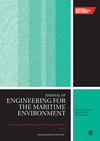船用中速双燃料发动机的油排放机理研究
IF 1.5
4区 工程技术
Q3 ENGINEERING, MARINE
Proceedings of the Institution of Mechanical Engineers, Part M: Journal of Engineering for the Maritime Environment
Pub Date : 2023-12-08
DOI:10.1177/14750902231213449
引用次数: 0
摘要
与船用柴油发动机相比,引燃式奥托船用发动机以大大减少空气污染物(硫氧化物、氮氧化物、微粒)的排放而闻名。然而,润滑油排放量仍然比陆基系统高出一个数量级。为了确定减少的潜力,必须更好地了解石油排放机制。为此,在一台中速船用发动机上进行了质谱油排放测量和荧光润滑膜厚度测量。利用荧光测量系统,可以以亚曲柄角分辨率对缸壁上润滑油膜的变化进行可视化分析。通过将所开发的校准方法应用于测量数据,可以确定油膜厚度以µm为单位。结果表明,与进气冲程相比,在点火后,活塞环在衬垫上向下移动时留下的油膜几乎减半。作者进一步能够检测和时间工作点依赖环旋转和调查显示环旋转和缸套温度分布之间的联系。调整环隙允许吹气发生。这和其他高强度事件,如发动机爆震、负载脱落或从柴油模式到燃气模式的转变,严重扰乱了油层,导致油排放达到峰值。本文章由计算机程序翻译,如有差异,请以英文原文为准。
Investigation of oil emission mechanisms in a marine medium-speed dual-fuel engine
Pilot-ignition Otto marine engines are known for greatly reduced emissions of air pollutants (sulphur oxides, nitrogen oxide, particulates) compared to marine diesel engines. However, lubricating oil emissions still are about one order of magnitude higher than in land-based systems. To identify reduction potentials, a better understanding of oil emission mechanisms has to be gained. For this purpose, mass spectrometric oil emission measurements and fluorescence lubricating film thickness measurements were performed on a medium-speed marine engine. With the fluorescence measuring system, the varying lubricating oil film on the cylinder wall can be visualised and analysed in sub-crank-angle resolution. By applying the developed calibration method to the measurement data, the oil film thickness can be determined in µm. It is shown that the oil film left by the piston rings on the liner as it moves down is almost halved after ignition compared to during intake stroke. The authors have further been able to detect and time operating point dependent ring rotation and investigations show a connection between ring rotation and cylinder liner temperature distribution. Aligning ring gaps allow blow-by to happen. This and other high intensity events such as engine knock, load shedding or the transition from diesel-mode to gas-mode, heavily disturb the oil layer and cause peaking oil emissions.
求助全文
通过发布文献求助,成功后即可免费获取论文全文。
去求助
来源期刊

CiteScore
3.90
自引率
11.10%
发文量
77
审稿时长
>12 weeks
期刊介绍:
The Journal of Engineering for the Maritime Environment is concerned with the design, production and operation of engineering artefacts for the maritime environment. The journal straddles the traditional boundaries of naval architecture, marine engineering, offshore/ocean engineering, coastal engineering and port engineering.
 求助内容:
求助内容: 应助结果提醒方式:
应助结果提醒方式:


